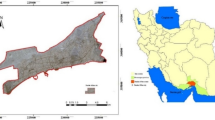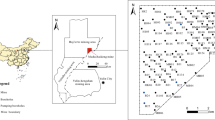Abstract
Zoning for the eco-geological environment (EGE) aims to protect and improve the regional ecological environment. It is the basis for evaluating the ecological characteristics of a mining area prior to mining activities and has the purpose of implementing water-preserved mining according to zoning type. In this study, four EGE types were proposed following field investigation in the Yushenfu mining area: oasis type with phreatic water and bottomland in desert (OTPWBD), oasis type with surface water and valley river (OTSWVR), loess gully type with surface runoff (LGTSR), and regional deep groundwater enrichment type (RDGET). Nine EGE evaluation indices were selected: rainfall, evaporation capacity, Luohe formation thickness, surface elevation, Sara Wusu aquifer water abundance, surface lithology, topography, slope, and normalized difference vegetation index (NDVI). Remote sensing technology and geographic information systems were first used to generate the evaluation index thematic maps. Then, the weight of each evaluation index was determined based on an analytic hierarchy process (AHP). Third, the index weight was used to form an improved weighted fuzzy C s clustering algorithm, and EGE zones were assigned using the MATLAB computing platform. For comparison, the AHP was also adopted for EGE zoning and a map of zoning differences was obtained. Finally, EGE field surveys of typical mines were carried out, which verified that EGE zoning using fuzzy clustering was accurate and reasonable.


















Similar content being viewed by others
References
Bondaruk, J., Janson, E., Wysocka, M., & Chałupnik, S. (2015). Identification of hazards for water environment in the Upper Silesian Coal Basin caused by the discharge of salt mine water containing particularly harmful substances and radionuclides. Journal of Sustainable Mining, 14(4), 179–187.
Candeias, C., Ávila, P. F., Ferreira, D., & Paulo, J. T. (2015). Integrated approach to assess the environmental impact of mining activities: estimation of the spatial distribution of soil contamination (Panasqueira mining area, Central Portugal). Environmental Monitoring and Assessment, 187(3), 135–158. https://doi.org/10.1007/s10661-015-4343-7.
Chen, M. X. (1999). A discussion on eco-geological environment system and comprehensive eco-environmental geological survey. Hydrogeology and Engineering Geology, 3, 3–6.
Chen, S. J., Yin, D. W., Cao, F. W., Liu, Y., & Ren, K. Q. (2016). An overview of integrated surface subsidence-reducing technology in mining areas of China. Natural Hazards, 81, 1129–1145. https://doi.org/10.1007/s11069-015-2123-x.
Chen, W., Xie, X., Peng, J., Shahabi, H., Hong, H., Tien, B. D., Duan, Z., Li, S., & Zhu, A. X. (2018a). GIS-based landslide susceptibility evaluation using a novel hybrid integration approach of bivariate statistical based random forest method. CATENA, 164, 135–149. https://doi.org/10.1016/j.catena.2018.01.012.
Chen, W., Pourghasemi, H. R., & Naghibi, S. A. (2018b). A comparative study of landslide susceptibility maps produced using support vector machine with different kernel functions and entropy data mining models in China. Bulletin of Engineering Geology and the Environment, 77, 647–664. https://doi.org/10.1007/s10064-017-1010-y.
Deng, S. B. (2014). ENVI remote sensing image processing method (pp. 310–345). Beijing: Higher Education Press.
Du, P. P. (2012). Research on geological environment effect and evaluation technology of coal mining in ecological fragile area (pp. 95–105). Xuzhou: China University of Mining and Technology.
Fan, L. M. (1992). Main environmental geological problems in Shenmu mining area. Hydrogeology and Engineering Geology, 6, 37–40.
Fan, L. M., Ma, X. D., & Ji, R. J. (2015). Advances in research and practice of water-preserved coal mining in ecologically fragile mining areas of western China. Journal of China Coal Society, 40(8), 1711–1717.
Galvin, J. (2017). Critical role of risk management in ground engineering and opportunities for improvement. International Journal of Mining Science and Technology, 27(5), 725–731. https://doi.org/10.1016/j.ijmst.2017.07.005.
Ghose, M. K., & Majee, S. R. (2002). Assessment of the status of work zone air environment due to opencast coal mining. Environmental Monitoring and Assessment, 77, 51–60. https://doi.org/10.1023/A:1015719625745.
Hu, W. Y. (1998). Mining and it’s negative affections on environment. Journal of China Coal Society, 23(5), 513–516.
Hu, Y. H., & He, S. H. (2000). Comprehensive evaluation method (pp. 51–72). Beijing: Science Press.
Hudak, P. F. (2010). Principles of hydrogeology (pp. 59–69). Beijing: Higher Education Press.
Jordan, G. (2009). Sustainable mineral resources management: from regional mineral resources exploration to spatial contamination risk assessment of mining. Environmental Geology, 53, 153–169. https://doi.org/10.1007/s00254-008-1502-y.
Lei, S. G., Bian, Z. F., Daniels, J. L., & He, X. (2010). Spatio-temporal variation of vegetation in an arid and vulnerable coal mining region. Mining Science and Technology, 20, 485–490. https://doi.org/10.1016/S1674-5264(09)60230-1.
Li, G. R., & Zeng, Y. Q. (2005). A discussion on geological environment and ecological environment. Geological Disasters and Environmental Protection, 16(1), 45–48.
Li, W. P., Duan, Z. H., Hua, J. M., Ye, G. J., & Zhao, X. J. (2000). Evaluation of present geological environment and prediction of its variation caused by mining in Yushenfu mine area of north Shannxi. Journal of Engineering Geology, 8(3), 324–333.
Li, P. Y., Li, X. Y., Meng, X. Y., Li, M. N., & Zhang, Y. T. (2016). Appraising groundwater quality and health risks from contamination in a semiarid region of northwest China. Exposure and Health, 8(3), 361–379. https://doi.org/10.1007/s12403-016-0205-y.
Li, P. Y., Tian, R., Xue, C. Y., & Wu, J. H. (2017a). Progress, opportunities, and key fields for groundwater quality research under the impacts of human activities in China with a special focus on western China. Environmental Science and Pollution Research, 24(15), 13224–13234. https://doi.org/10.1007/s11356-017-8753-7.
Li, M., Zhang, J. X., Deng, X. J., Zhou, N., & Zhang, Q. (2017b). Method of water protection based on solid backfill mining under water bearing strata and its application. Journal of China Coal Society, 42(1), 127–133.
Liu, J. W., Sui, W. H., & Zhao, Q. J. (2017). Environmentally sustainable mining: A case study of intermittent cut-and-fill mining under sand aquifers. Environmental Earth Sciences, 76(562). https://doi.org/10.1007/s12665-017-6892-2.
Liu, S. L., Li, W. P., & Wang, Q. Q. (2018a). Height of the water-flowing fractured zone of the Jurassic coal seam in northwestern China. Mine Water and the Environment, 37(2), 312–321. https://doi.org/10.1007/s10230-017-0501-1.
Liu, S. L., Li, W. P., Wang, Q. Q., & Pei, Y. B. (2018b). Investigation on mining-induced fractured zone height developed in different layers above Jurassic coal seam in western China. Arabian Journal of Geosciences, 11(2), 1–10. https://doi.org/10.1007/s12517-018-3383-z.
Liu, S. L., Li, W. P., Wang, Q. Q., He, J. H., & Xue, S. (2018c). Water inrush risk zoning and water conservation mining technology in the Shennan mining area, Shaanxi, China. Arabian Journal for Science and Engineering, 43(1), 321–333. https://doi.org/10.1007/s13369-017-2858-7.
Lu, Y., Akhtar, S., Sasmito, A. P., & Kurnia, J. C. (2017). Prediction of air flow, methane, and coal dust dispersion in a room and pillar mining face. International Journal of Mining Science and Technology, 27(4), 657–662. https://doi.org/10.1016/j.ijmst.2017.05.019.
Luo, J. J. (2005). MATLAB tutorial (pp. 44–51). Beijing: Electronics Industry Press.
Mou, N. X. (2012). ArcGIS10 geography information system tutorial (pp. 109–121). Beijing: Surveying and Mapping Press.
Nikitin, O., & Sabanov, S. (2005). Immediate roof stability analysis for new room-and-pillar mining technology in “Estonia” mine. Journal of Nuclear Cardiology, 13(4), 593–594. https://doi.org/10.17770/etr2005vol1.2138.
Panayotova, M. (1997). Impact of sulphide non-ferrous ore mining and dressing activities on the environment. Environmental Letters, 32(8), 2213–2228. https://doi.org/10.1080/10934529709376678.
Qiao, W., Li, W. P., Li, T., Chang, J. Y., & Wang, Q. Q. (2017). Effects of coal mining on shallow water resources in semiarid regions: A case study in the Shennan mining area, Shaanxi, China. Mine Water and the Environment, 36, 104–113. https://doi.org/10.1007/s10230-016-0414-4.
Salmi, E. F., Nazem, M., & Karakus, M. (2017). Numerical analysis of a large landslide induced by coal mining subsidence. Engineering Geology, 217, 141–152. https://doi.org/10.1016/j.enggeo.2016.12.021.
Sun, W. J., Wu, Q., Liu, H. L., & Jiao, J. (2015). Prediction and assessment of the disturbances of the coal mining in Kailuan to karst groundwater system. Physics and Chemistry of the Earth, 89-90, 136–144. https://doi.org/10.1016/j.pce.2015.10.008.
Trofimov, V. T. (2013). Current state, tasks, and problems of the further development of ecological geology. Moscow University Geology Bulletin, 68(3), 155–164. https://doi.org/10.3103/S0145875213030083.
Wang, S. J., & Zhou, P. G. (1995). The present situation and development trend of environmental geology. Journal of Engineering Geology, 3(4), 12–18.
Wang, K., Lin, Z. B., & Zhang, R. D. (2016). Impact of phosphate mining and separation of mined materials on the hydrology and water environment of the Huangbai River basin, China. Science of the Total Environment, 543, 347–356. https://doi.org/10.1016/j.scitotenv.2015.11.043.
Wang, G., Wu, M. M., Wang, R., Xu, H., & Song, X. (2017). Height of the mining-induced fractured zone above a coal face. Engineering Geology, 216, 140–152. https://doi.org/10.1016/j.enggeo.2016.11.024.
Wu, Q. (2003). Study of classification of geologic environmental problems in mines in China. Hydrogeology and Engineering Geology, 5, 107–112.
Xie, Z. K., & Zhang, M. (2018). Dynamic change regularity of ecosystem services in northern agro-pastoral ecotone with development of coal industry and coal-fired power generation. Journal of China University of Mining and Technology, 47(2), 436–442.
Xu, J. X., Zhao, H., Li, G., Wu, L. X., & Fu, J. C. (2017). Land ecological assessment and its spatial variation in coal mining area. Journal of China University of Mining and Technology, 46(1), 192–200.
Yang, Z. Y., Wang, W. K., Huang, J. T., & Duan, L. (2006). Research on buried depth of eco-safety about groundwater table in the blown-sand region of the northern Shaanxi Province. Journal of Northwest Sci-Tech University of Agriculture and Forestry (Natural Science Edition), 34(8), 67–74.
Yu, X. J. (2017). Coal mining and environmental development in southwest China. Environmental Development, 21, 77–86. https://doi.org/10.1016/j.envdev.2016.12.001.
Yu, B., Zhao, J., & Xiao, H. T. (2017). Case study on overburden fracturing during longwall top coal caving using microseismic monitoring. Rock Mechanics & Rock Engineering, 50(2), 507–511. https://doi.org/10.1007/s00603-016-1096-8.
Zhang, M. S., & Dang, X. Y. (2014). Water resources and their environmental problems in arid and semi-arid regions (pp. 23–25). Beijing: Science Press.
Zhang, M. S., Lu, N., & Chen, J. S. (2008). Vegetation ecological effects and countermeasures of groundwater development in northern Shaanxi energy and chemical industry base. Geological Bulletin, 27(8), 1299–1312.
Zhang, M. S., Dong, Y., Du, R. J., & Gu, X. F. (2010). Influence of coal mining on groundwater resources and countermeasures in Shanbei energy and chemical base. Earth Science Frontiers, 17(6), 235–246.
Zhang, T. W., Cai, Q. X., Han, L., Shu, J. S., & Zhou, W. (2017). 3D stability analysis method of concave slope based on the Bishop method. International Journal of Mining Science and Technology, 27(2), 365–370. https://doi.org/10.1016/j.ijmst.2017.01.020.
Funding
This work was supported by the National Basic Research Program of China (973 Program) under Grant 2015CB251601 and the State Key Program of the National Natural Science Foundation of China under Grant 41430643.
Author information
Authors and Affiliations
Corresponding author
Electronic supplementary material
ESM 1
(DOC 45 kb)
Rights and permissions
About this article
Cite this article
Li, W., Liu, S., Pei, Y. et al. Zoning for eco-geological environment before mining in Yushenfu mining area, northern Shaanxi, China. Environ Monit Assess 190, 619 (2018). https://doi.org/10.1007/s10661-018-6996-5
Received:
Accepted:
Published:
DOI: https://doi.org/10.1007/s10661-018-6996-5




